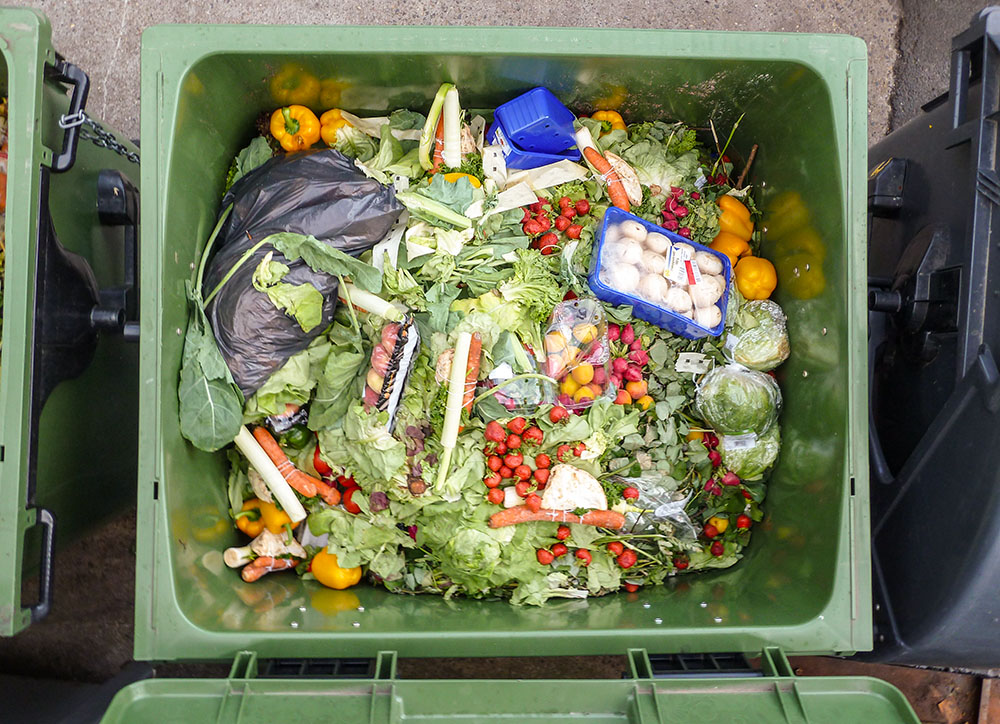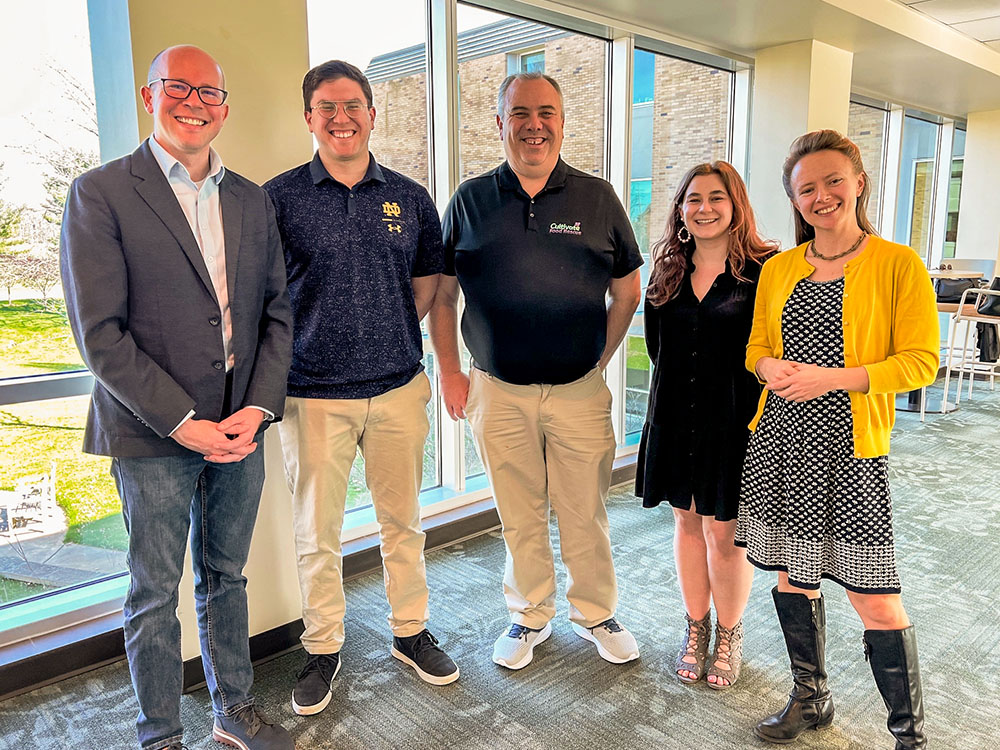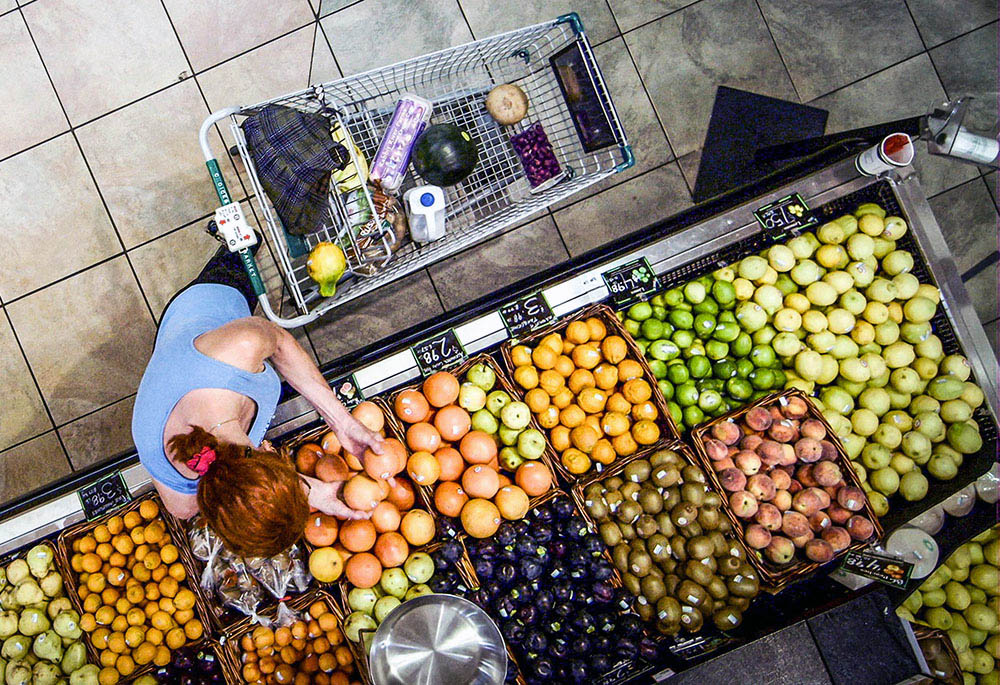
Discarded food is seen in a trash bin outside a store. "Forty percent of all food grown around the world for human consumption is wasted," Sally Geislar, assistant professor of environmental studies at St. Mary's College in Notre Dame, Indiana, said during an April 9 panel on food waste. (Wikimedia Commons/Foerster)
Though most college campus conversations about food are often students griping about dining hall meals, an April 9 panel discussion at St. Mary's College carefully explored the issues of food waste and how the future of food could be different.
"Urban Food Waste: Environmental, Social and Spiritual Dimensions" brought input from four people working closely and locally with food.
Sally Geislar, assistant professor of environmental studies at St. Mary's, introduced the panelists: Abbie Kawalec, a junior environmental studies major working at the college's sustainable farm; Karim Tinoco, a kitchen program manager from the nearby University of Notre Dame; Jim Conklin, executive director of Cultivate Food Rescue, a local food rescue organization; and Franciscan Fr. Daniel Horan, director of St. Mary's Center for the Study of Spirituality.
Geislar also offered a brief overview of growing global concerns about food waste.
"We see," she said, "that 40% of all food grown around the world for human consumption is wasted. In the developed world, the majority of this waste occurs at the point of retail and in the home. In fact, most households in the U.S. waste between 15 and 20% of the food that they take home from the grocery store, consequently losing thousands of dollars each year."
"This high level of food waste is occurring alongside high levels of food insecurity," she added. "In 2022, nearly 13% of people living in the U.S. were suffering from food insecurity and more than 7 million children were living in food insecure households. Unfortunately, these troubles are exacerbated for communities of color."

Participants on the April 9 panel "Urban Food Waste: Environmental, Social and Spiritual Dimensions" at St. Mary's College in Notre Dame, Indiana, included (from left): Franciscan Fr. Daniel Horan, Karim Tinoco, Jim Conklin, Abbie Kawalec and Sally Geislar. (Courtesy of St. Mary's College)
Geislar told the audience that speakers would share what they have learned about food, but would also comment on selected film clips being shown from "Just Eat It: A Food Waste Story." The film is a 75-minute 2014 documentary about a Canadian couple who decided to eat only discarded food for six months. Geislar recommended that everyone later view the entire documentary, available on YouTube.
Some clips focused on the plight of farmers forced to leave as much as 70% of their produce in fields because it was slightly blemished or didn't meet retail standards for grocery chains. Other clips explored food scarcity solutions and the environmental impact of food waste, especially greenhouse gas emissions from landfills.
"Something that's not talked about enough in the food waste conversation is the responsibility that retail stores have," said Tinoco, referring to a clip about slightly blemished produce left to rot.
"We should hold these companies accountable for these decisions that contribute to discarded and wasted food," he added. "But we haven't done that. We focus a lot on food waste in large institutions and restaurants, but there's a lot of waste beforehand that trickles down from the standards of retail grocery chains."
Conklin agreed with Tinoco. But he pointed out that American consumers must share the blame with retail chains.

A grocery shopper picks through fruit in the produce section. Most fruits and vegetables are culled due to aesthetic issues rather than safety concerns. (Courtesy of Peg Leg Films –Scene from "Just Eat It: A Food Waste Story")
"As American consumers," Conklin pointed out, "we create the standards. We don't shop at grocery stores where the produce doesn't look like it's the highest quality. Nonetheless, we can change those attitudes and can lobby grocery stores to be more responsible with food."
Conklin then said that consumers should ask their congressional representatives to support federal legislation around food date labeling. Many people are confused about what it means when they see a "best by" or "use by" or "discard by" date on canned or boxed food items, he said.
"There's a bill in Congress now which is called the Food Date Labeling Act of 2023 (H.R. 3159). It directs [the Department of Health and Human Services] to use two dates: a 'best by' date and a 'discard date,' " said Conklin. "This legislation has been before Congress 12 times, but it's not getting passed. We need national food date labels that are clear to the consumers because some states have no regulations, and some states have many. It's confusing for consumers."
Horan, who also teaches religious studies and philosophy at St. Mary's, told the audience that Pope Francis' 2015 encyclical, Laudato Si', reminded the world that "everything is connected." Horan also mentioned how the pope frequently criticizes "throwaway culture."
"This is more likely to be a problem in affluent cultures like ours," Horan said of the food waste crisis. "We are so disconnected from the source of the food that we consume."
Advertisement
Kawalec, an environmental studies major, talked about what she and other students have learned at the college's sustainable 5-acre farm at the north end of the campus. The farm produces fresh fruits and vegetables, which are shared with local families who are food insecure, students, staff, and also area homeless shelters.
This St. Mary's farm is also "home" to 160 chickens. They are well-fed, she said, but fed only with dining hall food scraps meticulously rescued by St. Mary's dining hall staff and students.
"We get about 42 dozen eggs a week," Abbie reported, smiling broadly. "We're able to get the eggs to food insecure people in the community through our markets. And students take dozens of the eggs and cook breakfast once a month at Our Lady of the Road, another outreach for the homeless in the city."
Tinoco agreed that there are wonderful lessons to learn from raising food properly. It can help us prepare for a healthier future where food is not wasted, he said.
"The people who created fertilizers, herbicides and pesticides years ago," he pointed out, "were concerned about how growing populations of people needed to be fed. These agricultural supplements were created to produce more food, though they've also created environmental problems."
Nodding his head about the need to do things in a new way, Conklin remarked: "One of the stats that I grapple with is that in this country, we waste enough food to feed 100 million people. And we have 35 million people who are classified as food insecure. So, it is possible to end hunger in this country three times over!"
"We need to combine sustainable farming practices with mass production to feed the whole population," he said. "We have to redirect that excess food. But it can be done."







